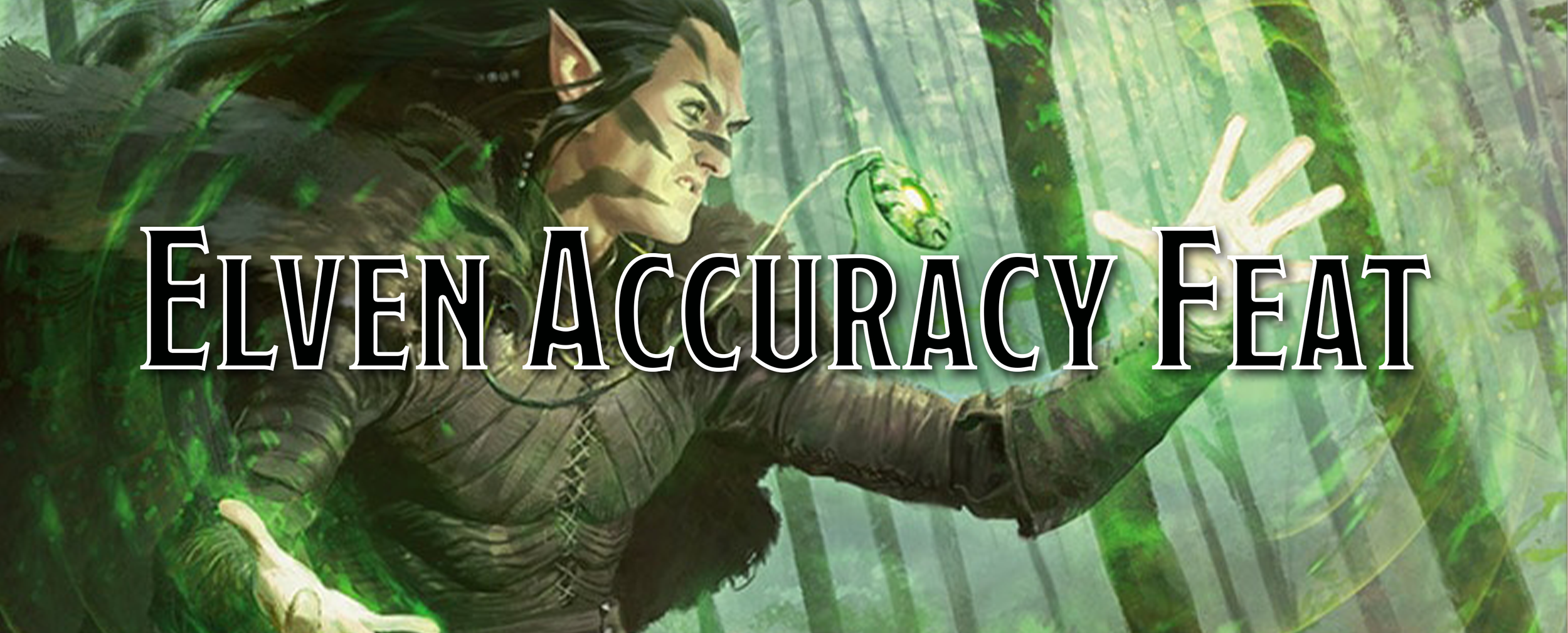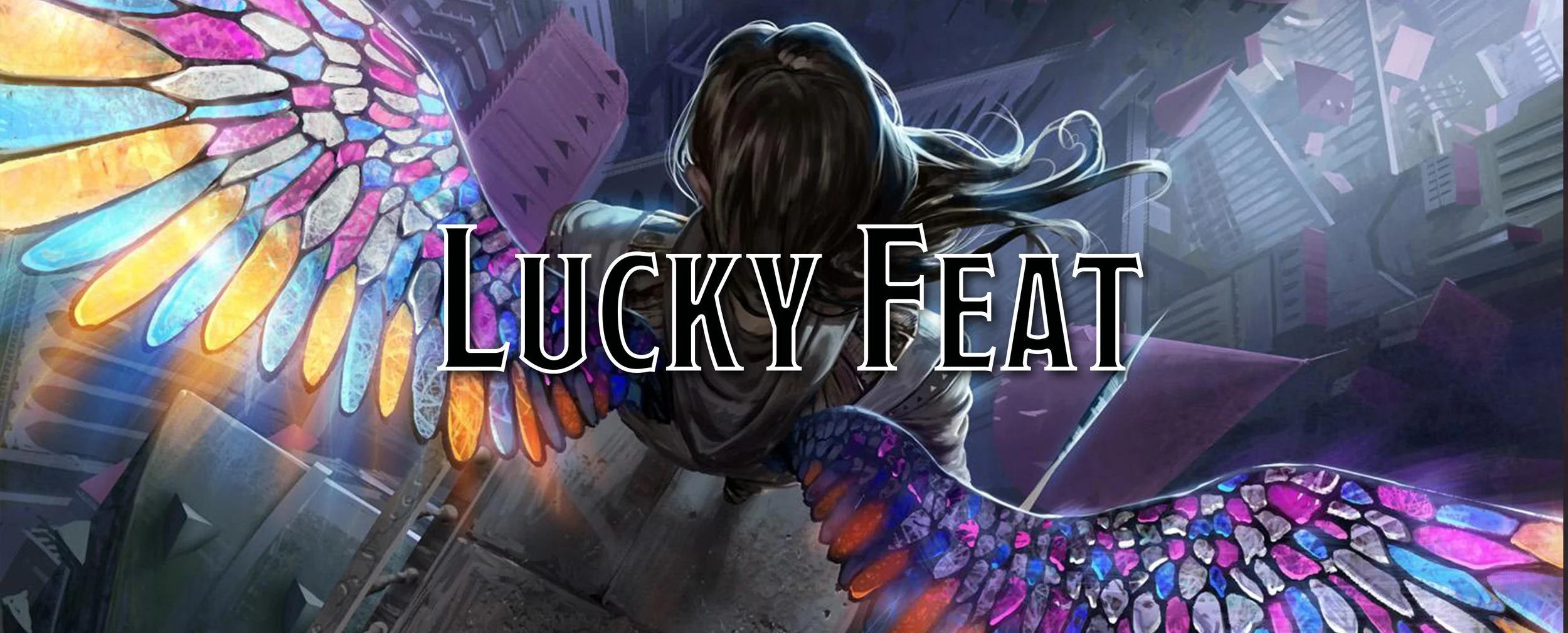A Player's Guide to Feats - Elven Accuracy
Are you playing an Elf or Half-elf? Do you like to roll as many d20s as possible to try a crit on your opponent, let alone hit them? The Eleven Accuracy feat could be a must-have, depending on your class and build. Why, you may ask? Let’s explore this racial feat and find out why.
What is the Elven Accuracy Feat
There’s a lot in just these few simple sentences. A lot of math is involved, but we’ll get to that in a bit.
Prerequisite: Elf or half-elf
The accuracy of elves is legendary, especially that of elf archers and spellcasters. You have uncanny aim with attacks that rely on precision rather than brute force. You gain the following benefits:
Increase your Dexterity, Intelligence, Wisdom, or Charisma score by 1, to a maximum of 20.
Whenever you have advantage on an attack roll using Dexterity, Intelligence, Wisdom, or Charisma, you can reroll one of the dice once.
Dissecting the Feat
First, this is a half-feat, so you gain +1 to a specified ability score. Many feats have no ability score increase, so anytime you get a +1, be happy. Most of the time, it's a defined stat, with a few even allowing you to choose from two. Elven Accuracy takes this to the extreme, giving you four options.
Dexterity will be the choice most of the time, but you should still weigh your options. Charisma is a popular choice, especially for spellcasters who take the feat. If you currently have an odd number one of the ability stats available via the feat, and a +1 will garner a bonus, consider putting the stat point there.
Onto the meat of the feat. Having an advantage and rolling 2d20 on an attack roll is nice, but rolling three dice is even better. That's right, 3d20s, since you can re-roll the lower of the two dice. I found a stupid amount of math with varying percentages in researching this feat. Most people want to know the probability of rolling a nat 20. I suck at math, but the general consensus is that you'll have a 14.26% of rolling a 20 on 3 dice (check out the Dice Probability Calculator). What I found very interesting and much more telling about the feat is the average dice roll is approximately 15.5. Watch this video if you are into math and have half an hour to spare.
Your first opportunity to grab a feat is 4th level. Now let's say you're a Dex. based fighter with a Dexterity of 16. Rounded down, your average attack roll is 18. Did you know that CR 16 monsters have an average Armor Class of 18? While I don't recommend a 4th level party of adventurers trying to take on a Marilith or Phoenix, take solace that you have a decent chance of hitting the creatures with this feat. That is, of course, right before it kills you.
The Elven Accuracy Feat Useability by Class
Before we start, a couple of notes. Two-weapon fighting makes the feat a great option. If you use the flanking rules in your campaign, melee fighters, especially Dex-based ones, must take this feat.
I'm providing a list of low-level spells, excluding ones that can knock you Prone, that can give advantage in a useful way in conjunction with the feat. Bolded spells are especially useful in conjunction with the feat.
Cantrip
true strike (Action to cast, gain advantage on your first attack roll against the target, 1 round),
1st level
color spray (Action to cast, blinded, 1 round)
ensnaring strike (Bonus Action, restrained, up to 1 minute)
entangle (Action, restrained, up to 1 minute)
faerie fire (Action, gain advantage on your first attack roll against the target, 1 minute)
sleep (Action, unconscious, until creature takes damage)
snare (Action, restrained, up to 8 hours)
2nd level
blindness/deafness (Action to cast, blinded, up to 1 minute)
hold person (Action, paralyzed, up to 1 minute)
Maximilian’s Earthen Grasp (Action, restrained, up to one minute)
pyrotechnics (Action, blinded, 1 round)
web (Action, restrained, up to 1 hour)
3rd level
blinding smite (Bonus Action, blinded, up to 1 minute),
Artificer: Not great, but not as bad as you may think. Intelligence is your spellcasting ability, and an artificer will also be using their Intelligence modifier for their attack rolls. Therefore, a +1 to Intelligence is nothing to shake a stick at. The biggest problem is trying to get advantage when attacking.
The Radiant Weapon infusion is one option. You can use your reaction after being hit by an attack to expend 1 (of 4) charges to blind the attacker until the end of their next turn unless the attacker succeeds on a Constitution saving throw against your spell save DC (There's that +1 Int coming in handy again).
If you use flanking rules at your table, you can gain advantage by positioning your Homunculus Servant or Steel Defender (Battle Smith) in a flanking position. It's too bad they take their turn immediately after yours, or both creatures could constantly use the Help action to provide advantage.
Barbarian: Ever play a Dex barbarian? I thought not. Not worth taking.
Bard: A bard's spellcasting ability is Charisma, and it's not uncommon to build a Dex-based Bard. The problem, much like the artificer above, is finding a way to gain a consistent advantage on your attack. The bard has a number of the spells listed above to gain advantage over an opponent, but the feat is still not a great option.
Cleric: Not worth taking.
Druid: Druid has access to some of the spells listed above, but it's not worth taking unless…
A Circle of the Shepherd druid that takes the Hawk Spirit totem can spam their reaction to grant advantage on their attack rolls. It feels broken, but I don't write the rules.
Fighter: If you're playing the Samurai archetype, this is a feat you'll want to take. Their Fighting Spirit ability allows you, as a Bonus Action, to give yourself advantage on weapon attack rolls until the end of the current turn. You can use this feature three times per long rest. The number of Attacks you can make on your turn can get crazy. Starting at 2nd level, you can use Action Surge to attack twice once per rest. At 5th level, you'll have two attacks per round, 11th level three attacks, and 20th level four attacks. As a bonus, you also gain 5 temporary hit points, which increases to 10 at the 10th and 15 at the 15th level. Neat.
The Gunslinger archetype also has several ways to grant advantage on attack rolls by using grit. Your grit points are equal to your Wisdom modifier (minimum of 1). What's really great is you regain 1 expended grit point each time you roll a 20 on the d20 roll for an attack with a firearm.
Deadeye Shot. When you make a firearm attack against a creature, you can expend one grit point to gain advantage on the attack roll.
Winging Shot. When you make a firearm attack against a creature, you can expend one grit point to attempt to topple a moving target. On a hit, the creature suffers normal damage and must make a Strength saving throw or be knocked prone.
In addition, with the gunslinger's Vicious Intent ability, your firearm attacks score a critical hit on a roll of 19-20, and you regain a grit point on a roll of 19 or 20 on a d20 attack roll.
Monk: There are too many other great feats for the Monk to take this feat.
Paladin: The Oath of Vengeance Paladin should be given some consideration. Using the channel divinity Vow of Eminty option, you can use your Bonus Action to gain advantage on attack rolls against the creature for 1 minute. Smite every time, and you can use your bonus action to use an additional smite spell.
Ranger: Several people have discussed taking this feat if you're a Beast Master ranger. Your furry friend can indeed use the Help action to provide you with advantage. The problem is commanding your companion to Help requires an Action. You'll have to wait until the 7th level when you can use your Bonus Action instead of an Action for the feat to be effective.
Beyond that, the ranger suffers, like many other classes, from trying to find a way to consistently gain advantage.
Rogue: Take the damn feat. There are so many ways for the rogue to gain advantage on their attacks. I could write another article on Sneak Attack alone.
Sorcerer: It's limited, but the feat can be useful in some ways. First, you can throw that +1 into Charisma. Here's a fun trick if you are okay with using 2 sorcery points. Make your regular attack action. Use Quickened Spell metamagic to change the casting time of true strike to a bonus action and cast a big attack spell next turn with advantage.
Wild Magic sorcerers can have a reasonably consistent advantage because of their Tides of Chaos ability. You can only use it once per long rest. If the DM has you roll on the Wild Magic Surge table immediately after you cast a sorcerer spell of 1st level or higher to regain the use of this feature.
Warlock: I'm not really into a Warlock taking this feat, but there are some uses if you do. Pact of the Chain lets you use the find familiar spell to have your imp, pseudodragon, or other warlock familiar to use the Help action to grant you advantage.
The Archfey's Misty Escape allows you to teleport away and become invisible as a Reaction. You remain invisible until the start of your next turn or until you attack or cast a spell. Unfortunately, you can only use this ability once per short or long rest. You also have access to the faerie fire spell, another way to gain advantage, so you sit 120 feet back and cast eldritch blast over and over at them.
Wizard: Not worth taking.
Conclusion
Elven Accuracy is almost a requirement for rogues but can also be incredibly beneficial for other classes. While the feat's benefits are only two sentences long, they pack a punch. If you can figure out how to gain advantage regularly, the Elven Accuracy feat is a must-have regardless of your class.
If you like our articles, love Homebrew, and are looking for a fun and active community to talk about all things D&D, consider supporting us on Patreon. Below are some of the benefits we offer:
Access to our Homebrew Horde with over 500 items and counting!
Vote on upcoming Deep Deep topics
Step by Step assistance in creating your own homebrew
Early access to Deep Dive and Rewind Articles
Free download of every item in the Dump Stat Store
Exclusive audio from our new YouTube Deep Dive series
Art Credit - Wizards of the Coast































